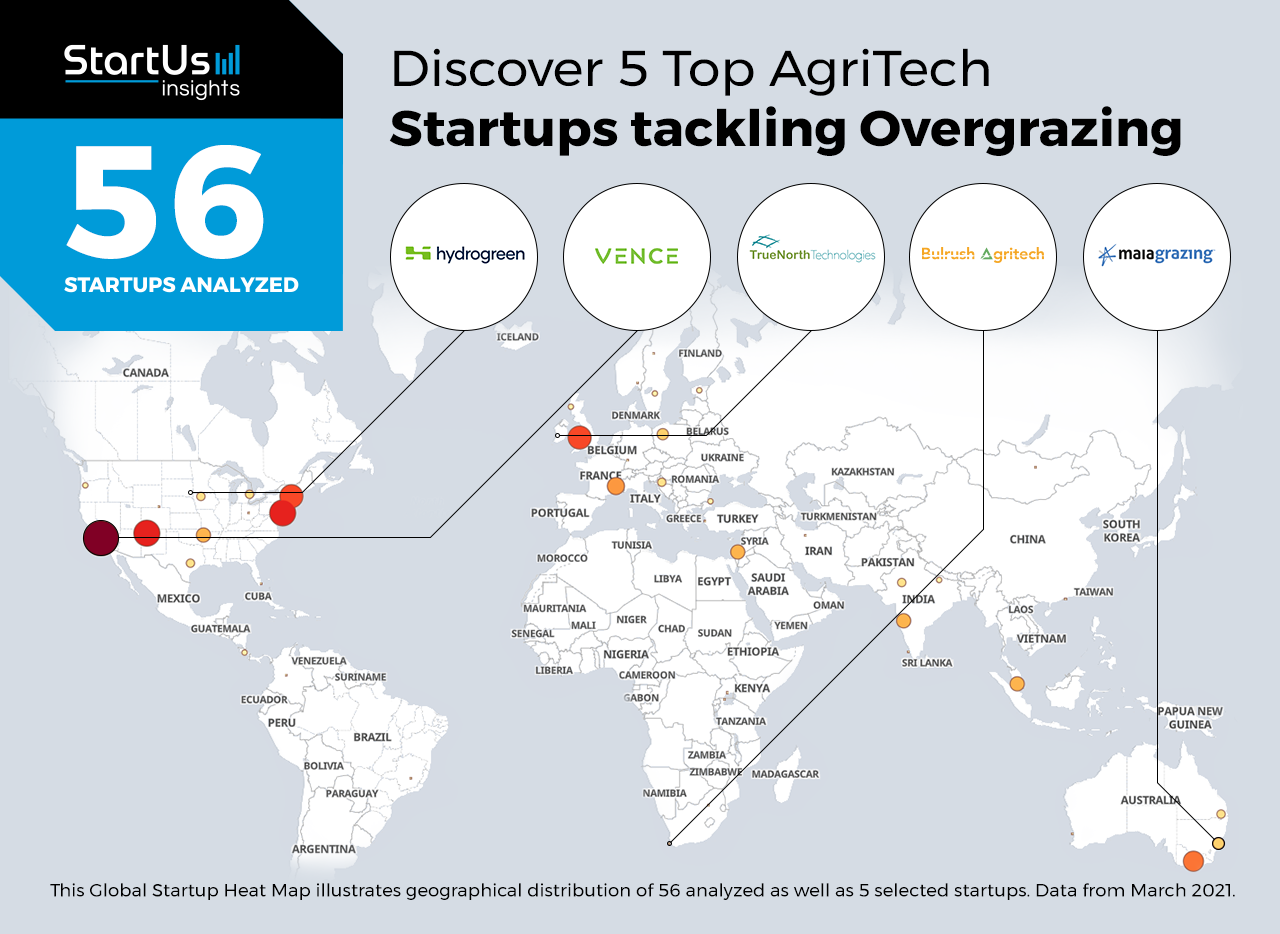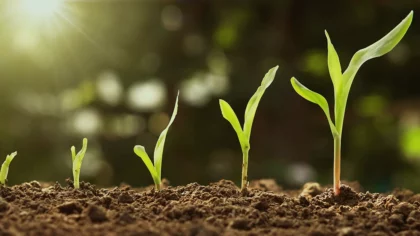Staying ahead of the technology curve means strengthening your competitive advantage. That is why we give you data-driven innovation insights into the agriculture industry. This time, you get to discover 5 hand-picked startups tackling overgrazing.
Global Startup Heat Map highlights 5 Top Startups tackling Overgrazing out of 108
The insights of this data-driven analysis are derived from the Big Data & Artificial Intelligence-powered StartUs Insights Discovery Platform, covering 1.379.000+ startups & scaleups globally. The platform gives you an exhaustive overview of emerging technologies & relevant startups within a specific field in just a few clicks.
The Global Startup Heat Map below reveals the distribution of the 56 exemplary startups & scaleups we analyzed for this research. Further, it highlights 5 startups tackling overgrazing that we hand-picked based on criteria such as founding year, location, funding raised, and more. You get to explore the solutions of these 5 startups & scaleups in this report. For insights on the other 51 startups tackling overgrazing, get in touch.
Maia Technology works on Graze Planning
Overgrazing, caused by improper pasture management, leads to soil erosion, land degradation, and hungry livestock. To prevent overgrazing, farmers and ranchers often apply rotational grazing practices and use grazing charts to calculate forage balance and establish a stocking rate. However, maintaining a grazing chart system requires aggregating data from scattered paperwork, making it a time-intensive task. Therefore, startups develop digital solutions for grazing calculations.
Australian startup Maia Technology offers farmers and ranchers a platform for graze planning. The startup’s MayaGrazing platform allows users to match stocking rate to carrying capacity. It also provides an overview of herd location habits and rainfall summary, as well as a dynamic grazing chart. By optimizing graze planning and feed budgeting, MayaGrazing allows farmers to maximize their pasture utilization and the resulting profits.
Bulrush Agritech advances Grassland Management
Proper grazing management increases pasture resilience during droughts, improves animal health, and decreases expenses on animal feed. To apply grazing management practices, farmers calculate the stocking rate of their livestock and the carrying capacity of their fields. To this avail, startups develop tools that perform such calculations based on an extensive weather history and farmers’ livestock management practices.
South African startup Bulrush Agritech develops a grassland management solution for optimized grazing. The startup’s platform, The Stockman, allows farmers to optimize their stocking rate by classifying the animals for easier grazing management. Additionally, the software enables rainfall recording and tracking for carrying capacity calculations. By monitoring the weather changes, livestock data, and the relationship between stocking rates and carrying capacities, the tool helps farmers avoid overgrazing and successfully manage pastures during severe climate conditions.
Vence works on Virtual Fencing
Commonly, for rotational grazing, farmers use static fences to limit cattle to a certain area on the field for feeding while the grass on the rest of the field regenerates. However, effective use of pastures requires frequent relocation of the fences and requires intensive manual labor. Therefore, startups and researchers develop solutions that enable dynamic fencing, eliminating the need for physical fences.
US-based startup Vence develops a virtual fencing solution for pasture management. The startup’s technology combines GPS and an audio device attached to the animal. It exploits animals’ susceptibility to audial cues and allows farmers to control cattle behavior from a smartphone or using a scheduler. Additionally, the startup applies AI to determine the optimal pasture schema for rotational grazing, helping farmers save costs on static fencing and manual labor associated with fence relocations.
True North Technologies provides a Grass Cover Measurement System
Proper timing is an important aspect of rotational grazing as a paddock needs substantial grass cover to sustain the herd for an extended period. Farmers measure paddocks for total grass cover to determine the readiness of the fields for rotation. Startups develop sensor solutions that collect grass growth information and transfer it to field management platforms.
Irish scaleup True North Technologies develops a grass-cover measurement system for rotational grazing. The startup’s system, Grasshopper, consists of a sensor unit, a plate meter, and an app for data visualization and analysis. The system allows farmers to efficiently determine when a paddock is ready for grazing, as well as identify poorly performing paddocks.
HydroGreen offers Indoor Grass Production
Indoor, automated agriculture offers an effective solution to the overgrazing problem. Startups develop solutions that shift primary livestock feeding sources from paddocks to indoor-produced nutrients. Such solutions allow farmers to free a portion of their land from grazing and commit it to other activities, such as crop farming, thereby unlocking an additional source of revenue.
US-based startup HydroGreen develops an automated indoor vertical hydroponics system for grass production. The system allows farmers to consistently grow the seeds of their choice, eliminating weather impact and reducing water consumption. HydroGreen enables a consistent diet for livestock and eliminates the negative impacts of overgrazing.
Discover more AgriTech startups
AgriTech startups such as the examples highlighted in this report focus on grassland management, precision farming, and livestock management. While all of these technologies play a major role in advancing agriculture, they only represent the tip of the iceberg. To explore more AgriTech technologies, simply get in touch to let us look into your areas of interest. For a more general overview, you can download our free AgriTech Innovation Report to save your time and improve strategic decision-making.









